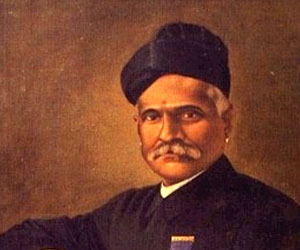Here is a brief biography and history of Indian
painter Raja Ravi Varma. Read information on Raja Ravi Varma paintings
Raja Ravi Varma Biography

Born: April 29, 1848
Died: October 2, 1906
Achievements: Raja Ravi Varma was one of the greatest painters
in the history of Indian Arts. He brought Indian painting to the
attention of the larger world; provided a vital link between the
traditional Indian art and the contemporary art.
Raja Ravi Varma is considered as one of the greatest painters in the
history of Indian Arts. He is famous for his depiction of scenes from
the epics of the Mahabharata and Ramayana. Raja Ravi Varma is most
remembered for his paintings of beautiful sari clad women, who were
portrayed as very shapely and graceful. He is considered as modern among
traditionalists and a rationalist among moderns.
Raja Ravi Varma was born on April 29, 1848 in the royal palace of Kilimanoor,
25 miles from Thiruvananthapuram in Kerala, India. His parents were
Umamba Thampuratti and Neelakandan Bhattathiripad. At the age of seven
years he started drawing on the palace walls using charcoal. His uncle
Raja Raja Varma noticed the talent of Ravi Verma and gave him
preliminary lessons in painting. At the age of 14, Ayilyam Thirunal
Maharaja took him to Travancore Palace and he was taught water painting
by the palace painter Rama Swamy Naidu. He was later given lessons in
oil painting by a British painter, Theodor Jenson.
In 1873, Ravi Varma won the first prize at the Madras Painting
Exhibition. He achieved worldwide acclaim after he won an award for an
exhibition of his paintings at Vienna in 1873. He traveled throughout
India in search of subjects. He often modeled Hindu Goddesses on South
Indian women, whom he considered beautiful. He stayed in the city of
Bombay in Maharashtra for some years and drew many a beautiful
Maharashtrian woman.
Ravi Varma is particularly noted for his paintings depicting episodes
from the story of Dushyanta and Shakuntala, and Nala and Damayanti, from
the Mahabharata. Raja Ravi Varma was fascinated by the power and
forceful expression of European paintings, which came across to him as
strikingly contrasting to stylized Indian artwork. His paintings are
considered to be among the best examples of the fusion of Indian
traditions with the techniques of European academic art..
Some of the famous paintings of Raja Ravi Varma are:
- Lady Lost in Thought
- Damayanti Talking to a Swan
- The Orchestra
- Arjuna and Subhadra
- Lady with Fruit
- The Heartbroken
- Swarbat Player
- Shakuntala
- Lord Krishna as Ambassador
- Jatayu, a bird devotee of Lord Rama is mauled by Rawana
- Victory of Meghanada
- A Family of Beggars
- A Lady Playing Swarbat
- Lady Giving Alms at the Temple
- Lord Rama Conquers Varuna
- Romancing Couple
- Draupadi Dreading to Meet Kichaka
- Shantanu and Matsyagandha
- Shakuntala Composing a Love Letter to King Dushyanta
- Girl in Sage Kanwa's Hermitage
Raja Ravi Varma died on October 2, 1906.

